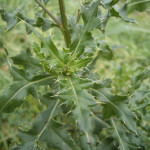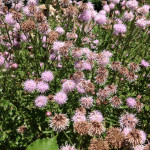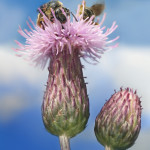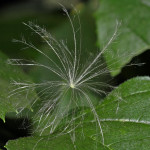Gallery:
- Canadian thistle leaf
- Canadian thistle flower heads
- Canadian thistle flowers
- Canadian thistle flower head and bracts
- Canadian thistle pappus
Common names:
Canada thistle, Canadian thistle, corn thistle, creeping thistle
Scientific Name:
Cirsium arvense (syns. Breea arvensis, Carduus arvensis, Cirsium incanum, Cirsium orchrolepideum, Cirsium setosum, Cnicus arvensis)
Description:
Canada thistle is a tall, prickly, creeping rhizomatous perennial with multiple purple flowers. The erect plant stands around 2 to 4 feet tall on rigid, hairy, branched stems that usually die back during winter. This aggressive noxious plant forms dense unisex patches on disturbed land, and produces allelopathic chemical that inhibit growth of other plants. Canada thistle is native to Europe, not Canada, and can be found throughout the United States.
Life cycle:
Height of mature plants
5 feet
Flower color:
Purple
Bloom time:
Flowers appear from June to October.
Look-a-likes:
There are several native and nonnative thistles that resemble Canada thistle. Please see this guide for identification clarification.
Habitat:
Canada thistle can be found in disturbed areas with abundant sun and moist but not wet soils. Crop fields, forest openings, gardens, hillsides, logged areas, pastures, range land, roadsides, stream banks, vacant lots and waste places are the usual infestation locations for Canada thistle. It is found throughout most of the continental United States.
Impacts:
Once established, it spreads quickly replacing native plants. It grows in circular patches, spreading vegetatively through roots which can spread 10 -12′ in one season. It poses an economic threat to the agriculture industry by reducing crop yields.
Noxious Weed Listing:
- WeedWise: Maintenance
- State of Oregon: Class B
- State of Washington: Class C
- Four County CWMA: Class C
Origin:
Europe and Asia
Links:
Oregon Noxious Weed Profile
Washington Noxious Weed Profile
Invasive.org profile
CABI Invasive Species Compendium





